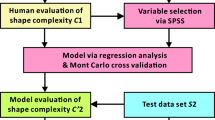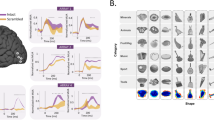Abstract
This paper proposes a biologically plausible matching method to recognize general shapes based on contour curvature information. The human visual system recognizes general shapes flexibly in real-world scenes through the ventral pathway. The pathway is typically modeled using artificial neural networks. These network models, however, do not construct a shape representation that satisfies the following required constraints: (1) The original shape should be represented by a group of partitioned contours in order to retrieve the whole shape (global information) from the partial contours (local information). (2) Coarse and fine structures of the original shapes should be individually represented in order for the visual system to respond to shapes as quickly as possible based on the least number of their features, and to discriminate between shapes based on detailed information. (3) The shape recognition realized with an artificial visual system should be invariant to geometric transformation such as expansion, rotation, or shear. In this paper, we propose a visual shape representation with geometrically characterized contour partitions described on multiple spatial scales.
Similar content being viewed by others
References
Asada H, Brady M (1986) The curvature primal sketch. IEEE Trans Pattern Anal 8(1): 2–14
Attalla E, Siy P (2005) Robust shape similarity retrieval based on contour segmentation polygonal multiresolution and elastic matching. Pattern Recogn 38(12): 2229–2241
Belongie S, Malik J, Puzicha J (2002) Shape matching and object recognition using shape contexts. IEEE Trans Pattern Anal 24(4): 509–522
Ben-Shahar O, Zucker S (2004) Geometrical computations explain projection patterns of long-range horizontal connections in visual cortex. Neural Comput 16(3): 445–476
Booth MC, Rolls ET (1998) View-invariant representations of familiar objects by neurons in the inferior temporal visual cortex. Cereb Cortex 8(6): 510–523
Brincat SL, Connor CE (2004) Underlying principles of visual shape selectivity in posterior inferotemporal cortex. Nat Neurosci 7(8): 880–886
Cui M, Femiani J, Hu J, Wonka P, Razdan a (2009) Curve matching for open 2D curves. Pattern Recogn Lett 30(1): 1–10
Daliri MR, Torre V (2009) Classification of silhouettes using contour fragments. Comput Vis Image Underst 113(9): 1017–1025
Drucker DM, Aguirre GK (2009) Different spatial scales of shape similarity representation in lateral and ventral LOC. Cereb Cortex 19(10): 2269–2280
Fukushima K (1980) Neocognitron: a self organizing neural network model for a mechanism of pattern recognition unaffected by shift in position. Biol Cybern 36(4): 193–202
Grossberg S (2009) ARTSCENE: a neural system for natural scene classification. J Vis 9: 1–19
Hubel D, Wiesel T (1962) Receptive fields, binocular interaction and functional architecture in the cat’s visual cortex. J Physiol 160(1): 106
Inui T (1988) Properties of human visual memory for block patterns. Biol Cybern 187: 179–187
Ito M, Tamura H, Fujita I, Tanaka K (1995) Size and position invariance of neuronal responses in monkey inferotemporal cortex. J Neurophysiol 73(1): 218–226
Klymenko V, Weisstein N, Topolski R, Hsieh CH (1989) Spatial and temporal frequency in figure-ground organization. Percept Psychophys 45(5): 395–403
Lamdan Y, Wolfson H (1988) Geometric hashing: a general and efficient model-based recognition scheme. In: IEEE Int Conf Comput Vis. IEEE Computer Society Press, Washington, pp 238–249
Latecki L, Lakamper R (2000) Shape descriptors for non-rigid shapes with a single closed contour. In: Proc CVPR IEEE, Hilton Head Island, pp 424–429
Leventhal aG, Thompson KG, Liu D, Zhou Y, Ault SJ (1995) Concomitant sensitivity to orientation, direction, and color of cells in layers 2, 3, and 4 of monkey striate cortex. J Neurosci 15(3 Pt 1): 1808–1818
Lier RV, Leeuwenberg E (1995) Multiple completions primed by occlusion patterns. Perception 24: 727–740
Mai F, Chang C (2010) Affine-invariant shape matching and recognition under partial occlusion. In: 17th IEEE ICIP, 2010, pp 4605–4608
Mokhtarian F (1995) Silhouette-based isolated object recognition through curvature scale space. IEEE Trans Pattern Anal 17(5): 539–544
Mokhtarian F (1997) Silhouette-based occluded object recognition through curvature scale space. Mach Vis Appl 10(3): 87–97
Mokhtarian F (2002) Shape similarity retrieval under affine transforms. Pattern Recogn 35(1): 31–41
Mokhtarian F, Mackworth A (1986) Scale-Based description and recognition of planar curves and two-dimensional shapes. IEEE Trans Pattern Anal Mach Intell 8(1): 34–43
Mokhtarian F, Mackworth A (1992) A theory of multiscale, curvature-based shape representation for planar curves. IEEE Trans Pattern Anal Mach Intell 14(8): 789–805
Mokhtarian F, Abbasi S, Kittler J (1997) Efficient and robust retrieval by shape content through curvature scale space. Ser Softw Eng Knowl 8: 51–58
Näsänen R (1999) Spatial frequency bandwidth used in the recognition of facial images. Vis Res 39(23): 3824–3833
Pasupathy A, Connor CE (2001) Shape representation in area V4: position-specific tuning for boundary conformation. J Neurophysiol 86(5): 2505–2519
Pasupathy A, Connor CE (2002) Population coding of shape in area V4. Nat Neurosci 5(12): 1332–1338
Richards W, Dawson B, Whittington D (1986) Encoding contour shape by curvature extrema. J Opt Soc Am A 3(9): 1483–1491
Riesenhuber M, Poggio T (1999) Hierarchical models of object recognition in cortex. Nat Neurosci 2(11): 1019–1025
Sajda P, Finkel LH (1995) Intermediate-level visual representations and the construction of surface perception. J Cogn Neurosci 7(2): 267–291
Sakai K, Inui T (2002) A feature-segmentation model of short-term visual memory. Perception 31(5): 579–589
Sekuler AB, Palmer SE, Flynn C (1994) Local and global processes in visual completion. Psychol Sci 5(5): 260–267
Sincich LC, Horton JC (2005) The circuitry of V1 and V2: integration of color, form, and motion. Annu Rev Neurosci 28: 303–326
Sprinzak J, Werman M (1994) Affine point matching. Pattern Recogn Lett 15(4): 337–339
Tanaka K (1996) Inferotemporal cortex and object vision. Annu Rev Neurosci 19: 109–139
Tanaka JW, Farah MJ (1993) Parts and wholes in face recognition. Q J Exp Psychol A 46(2): 225–245
Tarr MJ, Bülthoff HH (1998) Image-based object recognition in man, monkey and machine. Cognition 67(1–2): 1–20
Victor JD, Conte MM (2006) Encoding and stability of image statistics in working memory. Vis Res 46(24): 4152–4162
Williamson JR (1996) Neural network for dynamic binding with graph representation: form, linking, and depth-from-occlusion. Neural Comput 8(6): 1203–1225
Yang X, Koknar-Tezel S (2009) Locally constrained diffusion process on locally densified distance spaces with applications to shape retrieval. In: Proc CVPR IEEE, pp 357–364
Author information
Authors and Affiliations
Corresponding author
Rights and permissions
About this article
Cite this article
Matsuda, Y., Ogawa, M. & Yano, M. Visual shape representation with geometrically characterized contour partitions. Biol Cybern 106, 295–305 (2012). https://doi.org/10.1007/s00422-012-0496-4
Received:
Accepted:
Published:
Issue Date:
DOI: https://doi.org/10.1007/s00422-012-0496-4




